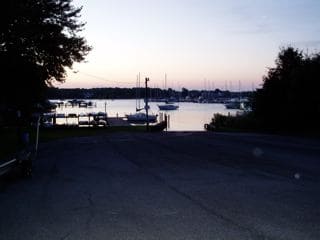Does the Greenpeace ship Esperanza need an Adams Atomic Engine?
Yesterday while on a long bike ride on one of my favorite local routes, I was listening to the NPR Environment Podcast. NPR’s (the initials stand for National Public Radio) description of the show is:
Environmental science and reporting on issues from Morning Edition, All Things Considered and other award-winning NPR programs.
I like listening to the program while thinking about how to make the world a better place. In my opinion, there is no better time to do that kind of thinking than while riding along soaking in the beauty of the world near my home. My wife and I are fortunate enough to live in one of the really nice parts of the globe with a temperate climate, plenty of water, and a gorgeous Bay with a shoreline that includes numerous rivers, inlets and creeks.
This is a photo taken near my home during an early morning bike ride. Unfortunately, I did not have my camera with me yesterday – it was one of those fall days that makes me, a Florida native, thankful for living in a place where there are seasons.

One of the stories on the program I had on my iPod yesterday was about an effort by Greenpeace to interfere with a Japanese government supported “scientific” whaling expedition. While I harbor no love for that organization, even a blind squirrel finds a nut now and again. When applied to people or organizations, that sentiment means that sometimes even really ignorant people can be correct on a particular topic and even groups whose main philosophy is diametrically opposed to mine can back a cause with which I agree.
When it comes to efforts to halt commercial whaling, I tend to agree with Greenpeace – there is no real justification in my mind for hunting whales and certainly no justification for killing as many as 1000 of them in the name of scientific study. You can hear Melissa Block’s interview with Karli Thomas, the leader of the Greenpeace expedition describe their planned intervention at Activists Aim to Block Japan’s ‘Scientific’ Whale Hunt.
Near the end of the story, Melissa asked Karli how long they intended to pursue their planned interference with the hunt. The response was very clear and practical – Karli explained that their time on station was dictated by the ship’s fuel storage capacity and the speed used. She stated that during the intervention, the speed would be dictated by the actions of the whaling fleet. In other words, if the whaling fleet used good evasive maneuvering techniques and had larger fuel tanks than the Greenpeace ship Esperanza, they would be able to outlast the intervention and continue their mission unhampered.
That was when the really weird thought popped into my head – I wonder if I will ever get a call from Greenpeace inquiring about the availability of an Adams EngineTM for their ship? With an engine like the ones that we are planning, the cores will last anywhere from 5-15 years depending on the operating profile of the ship. That would certainly give the Esperanza the speed and the legs to keep up with any whaling fleet.
There is a blog titled The Great Whale Trail Expedition being kept by the people on board the Esperanza. Based on yesterday’s post I would imagine that an Adams EngineTM would also be considered a boon by the crew members because it would allow the installation of a large capacity fresh water system without worrying about its effect on fuel consumption. I also noticed on the blog that whaling fleet is doing its best already to evade the activists and getting some assistance from the weather – the ship is rocking and rolling in a heavy storm.
If Greenpeace calls and asks if they can purchase an Adams EngineTM, how should I respond?
